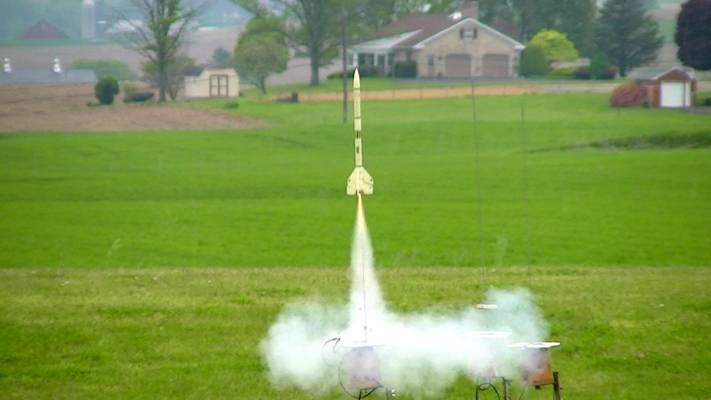The Beta: I love this little gem, but I haven't been able to get T sized booster motors any more.
UPDATE: Estes is now making them again - I have some due to arrive shortly! Yea!!!!!
I think the small size of this rocket combined with its high-altitude capabilities is better off with a bright Mylar streamer instead of the 10" parachute. This makes it easier to spot in the air and on the ground, and reduces drifting in the wind. This rocket was recently given my "Iris" modification, which extends the body tube about 5 inches above the streamer/parachute bay, and allows for a payload with an Altimeter One to measure altitudes. The A-power booster and A-power sustainer really lift this Beta high, over 700 feet on just two A's! I'd say that's pretty good proof that multi-stage rockets are more efficient with propellant, as the same mass of propellant made into a single B-motor would have topped-out at about 500 feet.
After a flight where the second stage did not light for unknown reasons, the Beta was badly damaged. It was repaired with a new and shorter payload section, and the body tube was lengthened to fix the worn-down top of the tube. This rocket is now 19-7/8" long with both stages.
What's great about this kit is you can fly a two stage very economically, since T motors are cheaper than standard sizes. (Iris is named after the Greek god of the rainbow. She is a messenger of the gods, linking the gods with humanity.) This rocket has flown higher than the Revel Casino Towers in Atlantic City, and the Met-Life Tower in NY, and could very easily fly over the St. Louis Gateway Arch.
| Flight Date: | 2012-05-06 |
| Rocket Name: | Beta |
| Kit Name: | Estes - Beta {Kit} (845) [1972-1984] |
| Flyer's Name: | Rich DeAngelis |
| Motors: | A10-0+A3-4 |
| Expected Altitude: | 750 Feet |
| Wind Speed: | 3.00 mph |
| Launch Site: | Penn Manor School Lancaster PA |
| Actual Altitude: | 157 Feet |
A10-0T booster, A3-4T sustainer: 157’ This classic rocket was on a first-time mission to gather performance data for a 2-stage flight. I pondered what kind of acceleration and speed would allow a model to surpass 750 feet on just a couple of mini A-motors. The first stage lit and the rocket accelerated to a peak of 17.7 Gs, while averaging 2.1 Gs. It reached a speed of 51 mph on just the energy of the A10 booster with a 1.1 second burn. At about 100 feet staging was to occur, but it did not happen.
The rocket coasted for 2.1 seconds, turned over at an apogee of 157 feet and came down ballisticly and planted the nosecone deep in the ground. The payload bay was torn and split wide-open, only the padding kept the structure contained and the altimeter protected. The booster and 2nd stage appeared fine for the most part.
Post-flight inspection of the engines showed a normally burned booster, intact scotch tape holding the two motors together, and the engine orientation was correct and the motor mount tubes true and sound. The nozzle of the 2nd stage motor was sooted from the "ejection" of the first stage booster.
I concluded that it was just dumb luck that none or not enough of the burning propellant from the first stage made its way into the 2nd stage motor nozzle. Neither of the two motors were old, having just been purchased in the last year and stored in dry air at moderate temperatures in sealed plastic cases. Go figure. What would happen if I put a little piece of that dark-brown ignitor squibb into the 2nd stage nozzle - would that catch more easily and flare up to start a more reliable ignition?
| Stage | Motor(s) |
|---|---|
| 1 | Estes A10T-0 |
 |
 |



